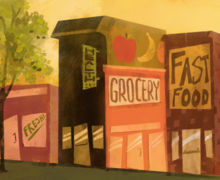Philadelphia University students, inspired by Grand Canyon painting, create kinetic machine
Courtesy of Charles Barilo
Charles Barilo, a Philadelphia University student, said the group analyzed the actual Grand Canyon and selected a portion of it they liked best to design their kinetic machine.
A group of students from Philadelphia University have combined art, geography and motion to recreate the Grand Canyon as a 3-D kinetic machine.
Charles Barilo, Peter Holderith and Zachary Samalonis, all freshmen at Philadelphia University, picked a painting at the Philadelphia Museum of Art as part of a school project and developed it into a machine using artist and inventor Leonardo da Vinci’s principles.
“Peter, Zach and myself all knew each other, and the talents and assets that we brought to the table and decided we would be a good fit for a group,” Barilo said in an email.
He said the group was originally unsure of which painting to choose, but as the museum was closing, a security guard said she wanted to show the group her favorite part of the museum.
“She ushered us into a gallery, and there was ‘Grand Canyon of the Colorado River,’ a beautiful painting by American artist Thomas Moran,” Barilo said.
He said the group analyzed the actual canyon and selected a portion of it that they liked best to design the machine.
Barilo and Samalonis had a background in Adobe Illustrator, he added, and they took the canyon map into Illustrator and began penning the different regions. They pitched the initial idea to the professors in the form of a non-working, foam model.
“At Philadelphia University, the professors structure the curriculum as if they are real-world clients. This allows us, even as freshman to gain real world experiences,” Barilo said.
After that process, the group spent time perfecting their design and working on issues that came up. They also created a second, simplified copy of the map, which sat on the inside of the machine under the visible map to help guide the dowels.
Assembling the device took four or five days and made necessary adjustments to make sure the gears meshed correctly and ensure the entire machine flowed seamlessly, Barilo said.
“Throughout the whole process we took videos and documented to create a process video so people could see how it all came together,” he also said.
Da Vinci’s principles that the group included in the project were “Demonstration,” a commitment to test knowledge through experience, persistence and willingness to learn from mistakes; “Art and Science,” which includes thinking, the development of the balance between science and art, logic and imagination; and “Curiosity” that approaches to life and a quest for continuous learning, according to The Da Vinci Institute for Technology Management.
Originally, Barilo said, they were intolerant when designing the map and the pieces would not flow up and down correctly. They later made adjustments and learned from their mistakes, he said.
“We learned about each other as friends and coworkers in the field, as well as the skills, knowledge, and expertise that each member of the group brought to the table,” he said.
Published on February 22, 2017 at 8:35 pm
Contact Deniz: dsahintu@syr.edu





